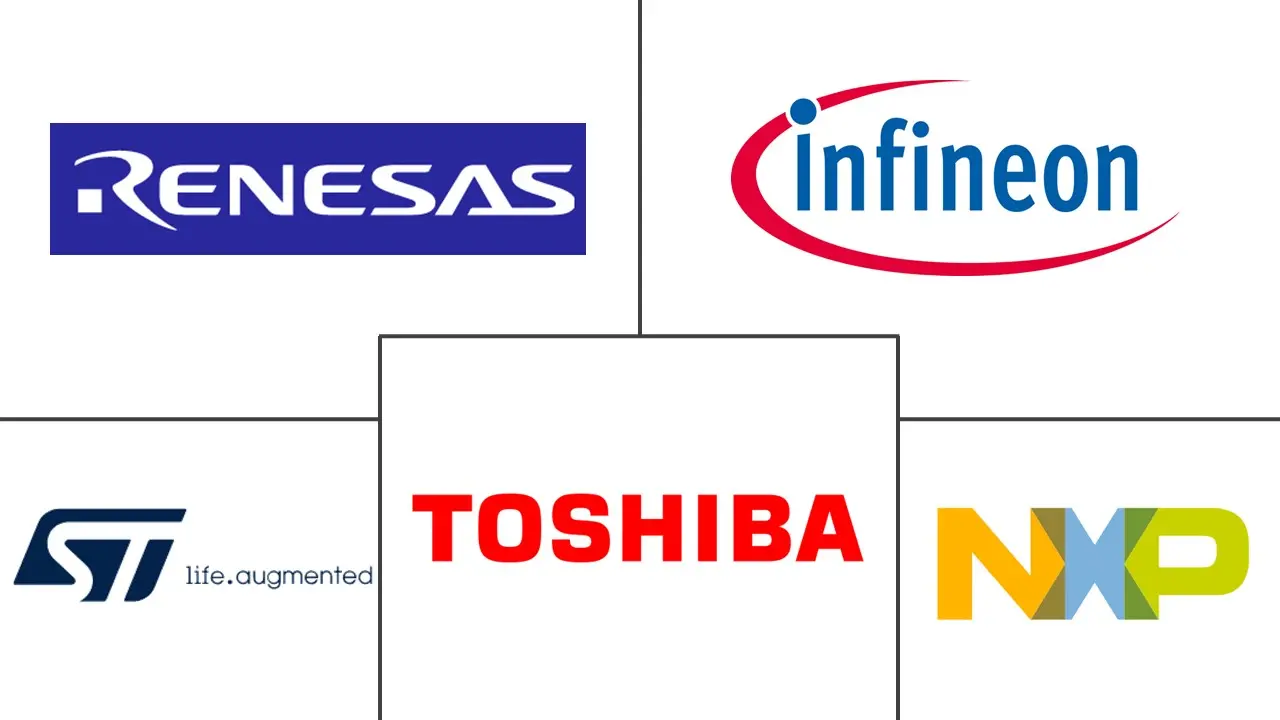Automotive Semiconductor Market Size
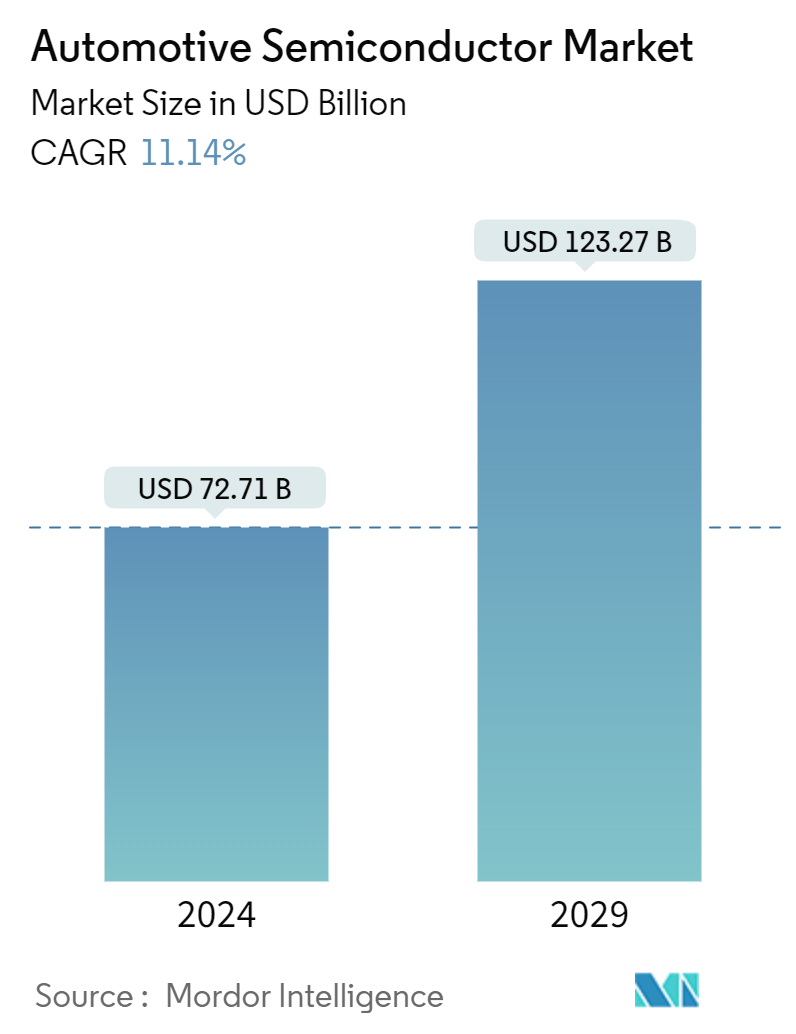
| Study Period | 2019 - 2029 |
| Market Size (2024) | USD 72.71 Billion |
| Market Size (2029) | USD 123.27 Billion |
| CAGR (2024 - 2029) | 11.14 % |
| Fastest Growing Market | Asia Pacific |
| Largest Market | Asia Pacific |
Major Players*Disclaimer: Major Players sorted in no particular order |
Automotive Semiconductor Market Analysis
The Automotive Semiconductor Market size is estimated at USD 72.71 billion in 2024, and is expected to reach USD 123.27 billion by 2029, growing at a CAGR of 11.14% during the forecast period (2024-2029).
- The automobile industry has transformed rapidly over the past few years with the advent of numerous advanced technologies, such as 3D mapping applications, electric vehicles, and automobile automation. This has increased the demand for several advanced semiconductors, including sensors, memory devices, ICs, and many more.
- Growth in automotive semiconductor sales globally mainly depends on vehicle sales and production trends, along with the increase in semiconductor deployment per vehicle, driven by the proliferation of electronic elements throughout the car. Due to the high degree of regulatory scrutiny and safety requirements worldwide, the automotive semiconductor market is characterized by zero-defect quality processes, stringent qualification processes, functionally safe design architecture, extensive design-in timeframes, high reliability, and long product life cycles, which would lead to significant demand for semiconductors in the automotive sector.
- According to the International Organization of Motor Vehicle Manufacturers (OICA), in 2023, over 93 million automobiles were manufactured worldwide. This was an increase of around 10% from 2022. The COVID-19 pandemic led to various changes in car buying behavior and customer attitudes. People readily accept digital services and features to stay connected, safe, and trackable.
- Hence, the increasing penetration of in-vehicle screens is expected to lead to the easy integration of many other digital features. Virtual assistants, voice recognition, personalization, and gesture control may also experience increased demand for growing concerns over touching surfaces. The automotive market is racing toward standardization, and A-PHY (serializer-deserializer (SerDes) physical layer interface) is expected to be the leading connectivity solution. The automotive ecosystem is merging around this standard, and it is expected that A-PHY will soon become a dominant connectivity solution in cars worldwide. However, the automotive semiconductor market is likely to face compelling challenges because of operating flaws in climatic conditions like extreme cold and heat.
- Post-COVID-19, various companies in the market are involved in different strategies, such as launches, acquisitions, and mergers, to gain a competitive edge.
Automotive Semiconductor Market Trends
Passenger Vehicles to Hold Major Market Share
- The growing demand for passenger electric vehicles is among the key drivers accelerating the demand for automotive semiconductors in passenger vehicles, as electric vehicles need a greater number of semiconductors compared to traditionally powered vehicles. For instance, according to Bloomberg Economy Forum, electric vehicle sales in India increased across all segments in 2023, with passenger electric vehicles approximately doubling to 96,000 units, 2.3% of all passenger vehicle sales.
- Based on components, the sensors segment is expected to drive market growth significantly. This is due to the increasing demand for ADAS features like adaptive cruise control and automatic emergency braking, driving the need for more sophisticated and powerful automotive semiconductors. These systems rely on sensors and processors to function efficiently.
- The increasing demand for safety systems can be linked to the introduction of ADAS or automated emergency braking systems and improved road safety rules, driving the demand for automotive semiconductor components worldwide.
- The European Union's compulsion of ADAS systems starting mid-2024 and a plan to introduce new regulations by the United Nations for the provision of additional driver assistance systems (DCAS and ADAS) that will come into force in January 2025 are anticipated further to drive market growth with increased demand for automotive semiconductors.
- Some countries in Europe, North America, and Asia-Pacific have approved legislation mandating different types of ADAS in consumer vehicles.
- The rising adoption of self-driving or autonomous vehicles is a crucial growth factor for the ADAS market, driving the growth of the automotive semiconductors market. For instance, according to Intel, global car sales are anticipated to reach around 101.4 million units in 2030, and autonomous vehicles are estimated to account for around 12% of car registrations by 2030.
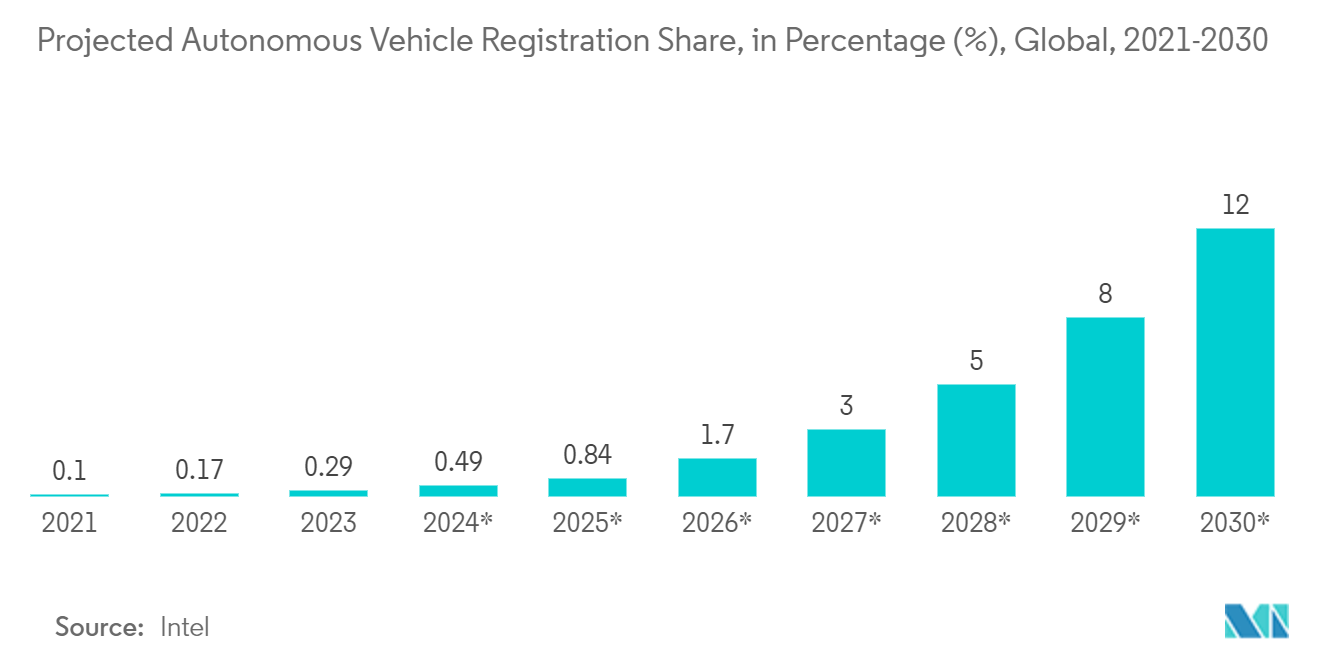
Asia Pacific to Register Significant Growth
- The increased automotive manufacturing and deepening partnerships between automotive OEMs and semiconductor manufacturers are propelling the Asia-Pacific automotive semiconductor market. Buyers prioritize a vehicle's comfort and luxury over traditional factors like cost and fuel efficiency.
- Global automakers, responding to the rising demand for luxury and semi-luxury vehicles, are increasingly outfitting their cars with electronic components. This trend is boosting the Asia-Pacific automotive semiconductors market, making the region a focal point for industry growth.
- The surge in electric vehicle demand is set to drive the Asia-Pacific automotive semiconductor sector further. As key automotive manufacturing nations witness a growing interest in self-driving cars, manufacturers are pressured to innovate and introduce such technologies. The future of fully autonomous vehicles hinges on various factors, from technological advancements and consumer acceptance to pricing and the industry's ability to address safety concerns. These factors will shape the trajectory of autonomous vehicles in the coming years.
- The automotive and semiconductor sectors are intensifying their focus on technology enhancements and raw material negotiations, integrating reliable technology into vehicles. For instance, NVIDIA's collaboration with Toyota, which enhances autonomous driving capabilities, highlights the industry's push toward advanced automotive technologies.
- Toyota's adoption of NVIDIA's DRIVE PX AI car computer platform underscores the commitment to developing cutting-edge autonomous driving systems. Such partnerships and innovations are pivotal in propelling the Asia-Pacific automotive semiconductor market forward.
- China is a key player in the Asia-Pacific automotive semiconductor landscape. The country's emphasis on safety features, the rise of infotainment applications like navigation, and the growing popularity of ADAS systems, featuring advanced functionalities such as parking assist and lane-departure warnings, are significant drivers of market growth.
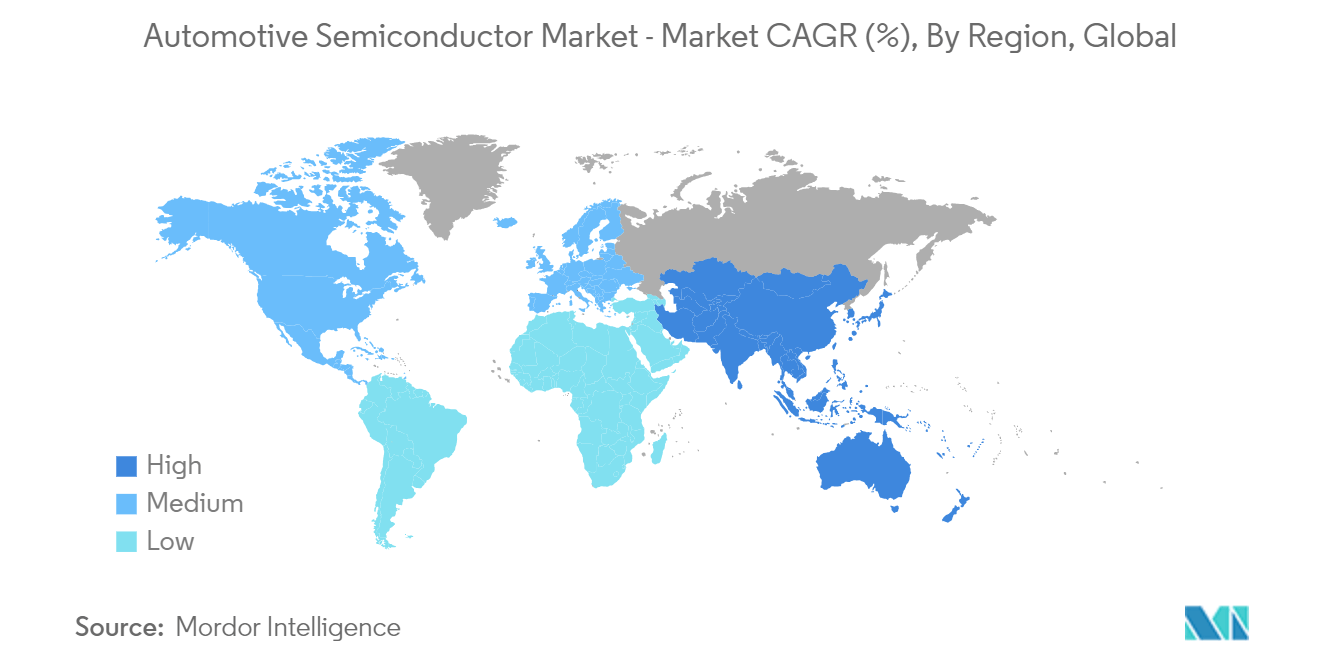
Automotive Semiconductor Industry Overview
The market studied fluctuates due to growing consolidation, technological advancement, and geopolitical scenarios. With the rising vertical integration of IDMs and foundries, the intensity of competition in the market is expected to increase, considering their ability to invest, which results from their revenues.
In a market where the sustainable competitive advantage through innovation is considerably high, the competition is likely to increase, considering the anticipated surge in demand from various automotive firms.
In such a situation, brand identity plays a major role, considering the importance of quality that the automotive firms expect from a semiconductor manufacturing player. The market penetration levels are also high with the presence of large market incumbents, such as NXP Semiconductor NV, Infineon Technologies AG, MediaTek Renesas Electronics Corporation, and Texas Instrument Inc..
- February 2024: Infineon Technologies AG announced that Infineon and Honda Motor Co. Ltd signed a memorandum of understanding (MoU) to build a strategic collaboration. Honda selected Infineon as a semiconductor partner to align future product and technology roadmaps. The two companies agreed to continue discussions on supply stability and encourage the transfer of mutual knowledge and collaboration on projects to accelerate the time-to-market technologies.
- November 2023: NXP Semiconductors NV announced the investment in and collaboration with Zendar Inc., a software start-up dedicated to revolutionizing autonomous vehicle systems with high-resolution radar. The investment accelerated and improved high-resolution radar solutions for advanced driver assistance systems (ADAS) and autonomous driving (AD) to complement NXP’s leading scalable radar portfolio.
- November 2023: Renesas Electronics Corporation laid out plans for its next-generation microcontrollers (MCUs) and system-on-chips (SoCs), targeting all significant applications across the automotive digital domain. The company shared its plans for two forthcoming MCU product advancements in the next-generation R-Car family. One is a recent crossover MCU series that delivers the high performance required for domain and zone electronic control units (ECU) in next-generation E/E automobile architectures. Secondly, the group plans to introduce a separate MCU platform tailored to the vehicle control market.
Automotive Semiconductor Market Leaders
-
NXP Semiconductor NV
-
Infineon Technologies AG
-
Renesas Electronics Corporation
-
STMicroelectronics NV
-
Toshiba Electronic Devices & Storage Corporation (Toshiba Corporation)
*Disclaimer: Major Players sorted in no particular order
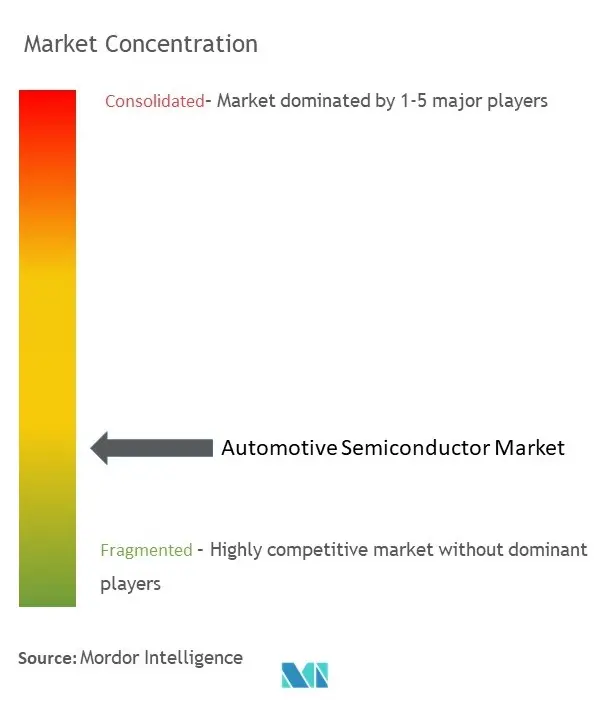
Automotive Semiconductor Market News
- April 2024: Infineon Technologies AG solidified its dominance in the automotive semiconductor market. TechInsights reported that Infineon bolstered its market share across all regions and maintained its top position in South Korea and China. Notably, Infineon achieved substantial progress in the Japanese automotive semiconductor sector. Infineon reinforced its standing as the second-largest player in Europe and secured a spot in the top three in North America.
- April 2024: Renesas Electronics Corporation, a premier supplier of advanced semiconductor solutions, announced that it started operations at its Kofu Factory, located in Kai City, Yamanashi Prefecture, Japan. Renesas aims to boost its production capacity of power semiconductors in anticipation of the growing demand for electric vehicles (EVs).
Automotive Semiconductor Market Report - Table of Contents
1. INTRODUCTION
- 1.1 Study Assumptions and Market Definition
- 1.2 Scope of the Study
2. RESEARCH METHODOLOGY
3. EXECUTIVE SUMMARY
4. MARKET INSIGHTS
- 4.1 Market Overview
-
4.2 Industry Attractiveness - Porter's Five Forces Analysis
- 4.2.1 Bargaining Power of Suppliers
- 4.2.2 Bargaining Power of Consumers
- 4.2.3 Threat of New Entrants
- 4.2.4 Intensity of Competitive Rivalry
- 4.2.5 Threat of Substitute Products
- 4.3 Industry Value Chain Analysis
- 4.4 Assessment of the Impact of COVID-19 and Other Macroeconomic Trends on the Market
- 4.5 Overview of RF Device Demand in Autonomous Vehicles
5. MARKET DYNAMICS
-
5.1 Market Drivers
- 5.1.1 Increasing Vehicle Production
- 5.1.2 Rising Demand for Advanced Safety and Comfort Systems
-
5.2 Market Restraints
- 5.2.1 Higher Cost of Advanced Featured Vehicles
6. MARKET SEGMENTATION
-
6.1 By Vehicle Type
- 6.1.1 Passenger Vehicle
- 6.1.2 Light Commercial Vehicle
- 6.1.3 Heavy Commercial Vehicle
-
6.2 By Component
- 6.2.1 Processors
- 6.2.2 Sensors
- 6.2.3 Memory Devices
- 6.2.4 Integrated Circuits
- 6.2.5 Discrete Power Devices
- 6.2.6 RF Devices
-
6.3 By Application
- 6.3.1 Chassis
- 6.3.2 Power Electronics
- 6.3.3 Safety
- 6.3.4 Body Electronics
- 6.3.5 Comforts/Entertainment Unit
- 6.3.6 Other Applications
-
6.4 By Geography***
- 6.4.1 North America
- 6.4.2 Europe
- 6.4.3 Asia
- 6.4.4 Australia and New Zealand
- 6.4.5 Latin America
- 6.4.6 Middle East and Africa
7. COMPETITIVE LANDSCAPE
-
7.1 Company Profiles*
- 7.1.1 NXP Semiconductor NV
- 7.1.2 Infineon Technologies AG
- 7.1.3 Renesas Electronics Corporaton
- 7.1.4 STMicroelectronics NV
- 7.1.5 Toshiba Electronic Devices & Storage Corporation (Toshiba Corporation)
- 7.1.6 Texas Instrument Inc.
- 7.1.7 Robert Bosch GmbH
- 7.1.8 Micron Technology
- 7.1.9 Onsemi (Semiconductor Components Industries LLC)
- 7.1.10 Analog Devices Inc.
- 7.1.11 ROHM Co. Ltd
8. INVESTMENT ANALYSIS
9. FUTURE TRENDS
** Subject To AvailablityAutomotive Semiconductor Industry Segmentation
The market for automotive semiconductors was evaluated by analyzing the market sizes of different components used in the automotive industry, such as sensors, processors, memory devices, discrete power devices, and integrated circuits. The report’s scope comprises analyzing various vehicle types worldwide, including light commercial vehicles, heavy commercial vehicles, and passenger vehicles.
The automotive semiconductor is segmented by vehicle type (passenger vehicle, light commercial vehicle, and heavy commercial vehicle), component (processors, sensors, memory devices, integrated circuits, discrete power devices, and RF devices), application (chassis, power electronics, safety, body electronics, comfort/entertainment unit, and other applications), and geography (North America, Europe, Asia-Pacific, Latina America, and Middle East & Africa). The report offers the market size in value terms in USD for all the abovementioned segments.
| By Vehicle Type | Passenger Vehicle |
| Light Commercial Vehicle | |
| Heavy Commercial Vehicle | |
| By Component | Processors |
| Sensors | |
| Memory Devices | |
| Integrated Circuits | |
| Discrete Power Devices | |
| RF Devices | |
| By Application | Chassis |
| Power Electronics | |
| Safety | |
| Body Electronics | |
| Comforts/Entertainment Unit | |
| Other Applications | |
| By Geography*** | North America |
| Europe | |
| Asia | |
| Australia and New Zealand | |
| Latin America | |
| Middle East and Africa |
Automotive Semiconductor Market Research FAQs
How big is the Automotive Semiconductor Market?
The Automotive Semiconductor Market size is expected to reach USD 72.71 billion in 2024 and grow at a CAGR of 11.14% to reach USD 123.27 billion by 2029.
What is the current Automotive Semiconductor Market size?
In 2024, the Automotive Semiconductor Market size is expected to reach USD 72.71 billion.
Who are the key players in Automotive Semiconductor Market?
NXP Semiconductor NV, Infineon Technologies AG, Renesas Electronics Corporation, STMicroelectronics NV and Toshiba Electronic Devices & Storage Corporation (Toshiba Corporation) are the major companies operating in the Automotive Semiconductor Market.
Which is the fastest growing region in Automotive Semiconductor Market?
Asia Pacific is estimated to grow at the highest CAGR over the forecast period (2024-2029).
Which region has the biggest share in Automotive Semiconductor Market?
In 2024, the Asia Pacific accounts for the largest market share in Automotive Semiconductor Market.
What years does this Automotive Semiconductor Market cover, and what was the market size in 2023?
In 2023, the Automotive Semiconductor Market size was estimated at USD 64.61 billion. The report covers the Automotive Semiconductor Market historical market size for years: 2019, 2020, 2021, 2022 and 2023. The report also forecasts the Automotive Semiconductor Market size for years: 2024, 2025, 2026, 2027, 2028 and 2029.
What are the factors driving the Automotive Semiconductor Market?
The key factors driving the Automotive Semiconductor Market are a) Increasing demand for advanced driver-assistance systems (ADAS) b) Growing demand for electric vehicles c) Increasing comfort and safety features in cars
What are the factors driving the Automotive Semiconductor Market?
The key factors driving the Automotive Semiconductor Market are a) Increasing demand for advanced driver-assistance systems (ADAS) b) Growing demand for electric vehicles c) Increasing comfort and safety features in cars
Automotive Semiconductor Industry Report
The global automotive semiconductor market is witnessing significant growth, driven by the increased adoption of electric and hybrid vehicles, the surge in demand for advanced vehicle safety and comfort systems, and the introduction of innovative technologies for an advanced user interface. However, the market faces challenges such as operational failures in extreme climatic conditions and the global chip shortage. Despite these hurdles, the market offers substantial growth opportunities, especially with the rising demand for advanced power semiconductors for improved performance and operational efficiency, and the emergence of autonomous vehicles. The market is segmented into component, vehicle type, propulsion type, and application, with Asia-Pacific dominating due to the integration of IoT and AI in the region's automotive industry. The advent of autonomous vehicles offers a unique opportunity for semiconductor manufacturers to partake in a technological shift. Businesses capable of providing reliable, high-performance, and energy-efficient semiconductor solutions tailored to autonomous driving are expected to significantly shape the future of transportation. Mordor Intelligence™ Industry Reports provide statistics for the Automotive Semiconductor market share, size, and revenue growth rate, including a market forecast outlook and a historical overview. A sample of this industry analysis is available as a PDF download.

